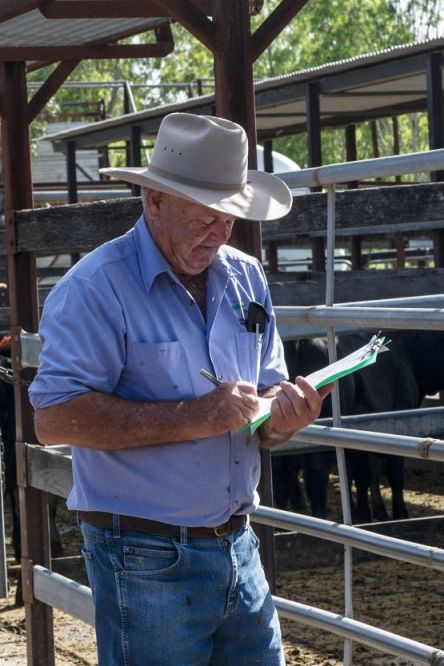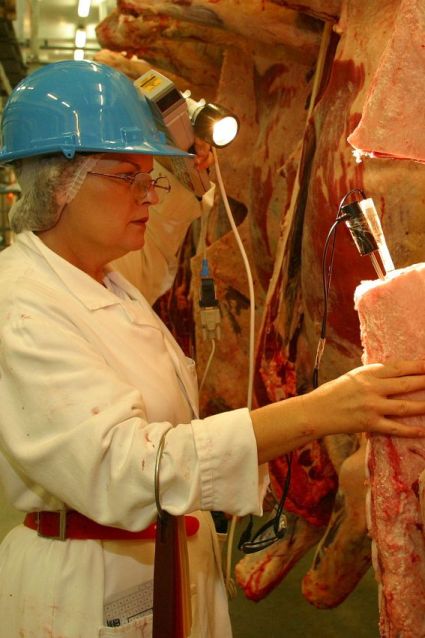Meeting market specifications

Key actions
- Know the specifications and customer requirements of your target markets.
- Know how to assess and monitor the progress of live animals towards target markets.
- Manage the grazing system to achieve growth targets and successful market outcomes.
- Use high nutritional quality finishing systems to ensure cattle keep growing to slaughter.
- Seek feedback and implement practices to improve the management of your production system.
- Regularly evaluate new marketing options and implement those more profitable to the beef enterprise.

Why is meeting market specifications important?
A successful grazing business makes a sustained profit by growing and converting pasture and conserved feed into beef products that consistently meet market specifications. Every producer strives to:
- gain a reputation as a reliable supplier of quality beef
- maintain market access to as many markets as possible
- be financially rewarded when a high proportion of stock consistently meets customers’ requirements.
This is a ‘win–win’ situation for both you and your customers.
A wide range of potential markets are available to beef producers in southern Australia, including the sale of weaners, vealers, feeder steers, backgrounding cattle for feedlots, bull beef, cull cows, pregnancy-tested in-calf heifers and cows, unjoined heifers, domestic and/or export trade finished cattle, animals for live export and niche market cattle. Each market has defined specifications for animals to return the highest price.
Beef producers are constantly faced with decisions on the type of cattle to produce or acquire, the management system employed to optimise their production, and the relevant market end point. These decisions are based on their experience and knowledge of their cattle’s performance, seasonal situation and potential to grow cattle, and the specifications of the various markets available to them.

This module concentrates on the short-term management decisions needed to meet product specifications, and is designed to help you identify the best priced market you can target and ensure you deliver a quality product to its requirements. The longer term options of changing your cattle genetics to better meet market specifications is more fully addressed in Module 4: Cattle genetics.
While genetics is important, you need to maintain the flexibility to diversify and realign your target markets and options depending on opportunities and changing production circumstances. There will be times when your pastures will not allow stock to meet target market specifications, or when alternative markets become more profitable. When these circumstances arise, maximum profitability may be achieved by selling animals in other markets, or by moving to alternative feeding strategies.
Clearly, there is a balance between maintaining long-term relationships with your regular customers and exploring new market opportunities. As specifications can vary between buyers and change over time, it is important that you review the specifications of targeted markets with your regular buyers as a matter of routine. This personal approach to market development may also involve entering into forward contracts or similar undertakings to ensure your cattle are marketed to achieve maximum profit.
How does this module assist you?
This module covers the period from the time calves are weaned to the point of sale, and includes the management of trading stock and culled breeding animals. It aims to help you increase financial returns by better meeting target market specifications, exploiting market opportunities and managing the risks.
A key aim is to apply recommended best practice to the nutrition, health and welfare of sale stock to meet the target market specifications at the predetermined time of sale. Regular evaluation of new market opportunities and alternative selling options (see Tool 7.5) also assist in sustaining the profitability of your beef enterprise. Managing the marketing system needs careful implementation based on previous experience, the anticipated rainfall pattern and seasonal outlook.
Achieving the highest price is not necessarily the best business option. The most profitable strategy is usually a combination of the best margin per kilogram with the maximum kilograms of beef produced/ha. Price and cost of production need to be considered along with the stocking rate (DSE/ha).
The value of meeting market specifications
Beef producers are continually making management decisions that influence how well their cattle meet market specifications. Achieving consistently high compliance rates in high value markets is an important profit driver for beef businesses. The number of animals failing to meet market specifications in Australia can be high, which results in lower dollar returns.
The cost of failing to meet market specificationsA study of 40,000 feedlot cattle records (Slack-Smith, 2009) reported how the extent that cattle not meeting market specifications impacted on the final quality, costs and delivery of the product. The details and consequences of failure to meet specifications in short-fed situations (20,000 head studied) were:
In long-fed situations (20,000 head studied):
|

Information collected from the live cattle marketplace by the National Livestock Reporting Service (NLRS) contains detail of price differences payable due to the variation and degree of muscle and fat. The key message is that meat processors and livestock buyers pay according to the degree of muscularity of a beast and, therefore, the potential yield in all cattle market categories (McKiernan, 2002).
Table 1 illustrates the price variations observed for different muscle and fat scores within the yearling steer 330–400kg category, which typically represents domestic trade steers. The table demonstrates the price advantage achieved for finished animals meeting preferred market specifications.
In this example, the optimum grade is clearly B3 (muscle score B and fat score 3), which averaged 8¢ above B2. However, these animals only represented 1% of total numbers. D muscled cattle received the greatest discounts, averaging up to 29¢/kg lower than C muscled cattle. 85% of medium weight yearling steers were C muscled, while 74% had fat score 3. More importantly, when the market shows a negative trend, the variation between the C and D muscled cattle widens as buyers apply larger discounts on the plainer muscled cattle.
| Muscle score B | Muscle score C | Muscle score D | |
| Fat score 2 | 184.1 | 169.5 | 140.3 |
| Fat score 3 | 192.1 | 176.0 | 152.9 |
| Fat score 4 | – | 178.9 | – |
Linkages to other modules
Module 1: Setting directions discusses identifying the most profitable target markets and times of sale in relation to pasture growth and other resources available to the beef enterprise, an essential step in planning and setting the direction of your beef enterprise.
Managing the grazing system to meet market specifications is about fitting together the livestock requirements (see Module 4: Cattle genetics, and Module 2: Pasture growth) and livestock responses (see Module 3: Pasture utilisation, and Module 6: Herd health and welfare) to satisfy market needs. Maximising the number of weaners available and appropriate for growing to meet target market/s is the focus of Module 5: Weaner throughput.
Principles of meeting market specifications
- Know the specifications and customer requirements of your target markets.
- Know your production system.
- Implement a plan to market cattle to specification on time (as opposed to producing cattle for sale and then finding a buyer who wants those specifications).
- Manage the grazing system to achieve livestock performance targets and successful market outcomes.
Procedures for meeting market specifications
- Procedure 1 – Know your market specifications
- Procedure 2 – Meet market specifications on time
- Procedure 3 – Achieve best carcase dressing percentage
- Procedure 4 – Evaluate market opportunities
